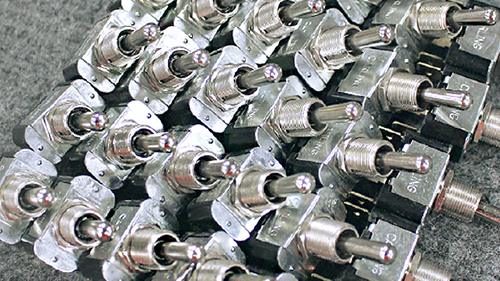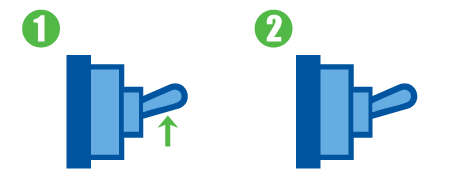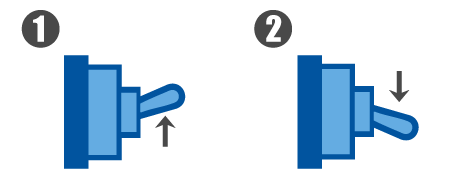Bat Toggle Switches: Maintained VS Momentary
Posted by Pacer on 22nd Oct 2025
What are bat toggle switches?
Bat toggle switches are one of the most common and easily recognizable types of switches you will find on marine vessels. They get their name from the baseball bat-shaped handle, also known as a bat lever, which is used to toggle them on and off.
Bat toggle switches are used across multiple industries due to their simplicity of use, long-term durability, and number of configurations available.

How do bat toggle switches work?
A bat toggle switch works by moving the switch position to open or close an electrical circuit. When the switch is activated, the power flows to the connected piece of equipment. Within the switch body, metal components either connect (power on, closed circuit) or disconnect (power off, open circuit) depending on the position of the switch's lever.
What types of bat toggle switches are available?
Bat toggle switches are available in a multitude of configurations, but they all fall into one of two categories: maintained (standard) or momentary. Regardless of the type of switch, the main function stays the same: to allow power to flow to a piece of equipment. The difference is in the internal components of the switch, which determine whether it will maintain the closed circuit or release it. Basically, the maintained switch will continue to send power until the switch lever is flipped, whereas the momentary switch will stop sending power once the switch is released. Let’s dig deeper on this topic.
Maintained Switch maintains position
Switch maintains position
Momentary Switch returns to original position
Switch returns to original position
What is the difference between maintained (standard) and momentary switches?
As we said above, the difference between maintained and momentary lies in how the power flow is interrupted. A simple way to think about it is that a maintained switch works like a light switch where once it is in the “on” position, it will stay there until moved to the “off” position. By contrast, the momentary switch works more like a car horn, where if you hold it down, the horn makes noise, but once you release it, the momentary action stops. Here is a handy chart that breaks down the differences between the two types.
|
Maintained (Standard) Switch |
Momentary Switch |
|
|
Operation |
Stays in the selected position until manually changed |
Returns to its default position when released |
|
Internal Mechanism |
A mechanical latch holds contacts in place |
The spring mechanism returns lever to neutral |
|
User Interaction |
The toggle is flipped to change the circuit state |
Must hold the toggle in place to maintain circuit activation |
|
Electrical Behavior |
Maintains connection continuously |
Connection only lasts if it’s held in the on position |
|
Typical Use |
Systems that need a steady on/off state, such as lights |
Systems needing short, controlled activation, such as a horn |
Where is each type designed to excel?
Although they are similar, each toggle switch type is designed for very specific purposes.
Maintained switches
Maintained switches are used in applications where the power needs to flow or be interrupted continuously until the other position is desired. For example, lighting is something you would use a maintained switch to operate. Otherwise, the moment you release the switch, the light will go out. Other examples would be powering bilge pumps, blowers, master power, or any other piece of equipment that would require consistent power to operate.
Momentary switches
Momentary switches are the ideal choice for applications that require temporary activation of equipment. For example, the starter on your boat motor would not be as efficient if activated by a maintained switch. Leaving the starter running longer would likely damage the starter itself. Other examples include operating trim tabs or jack plates where precise adjustments are needed.
One product that could go either way would be wipers. Some people may want wipers to run constantly until deactivated manually, whereas other operators may prefer that the wipers only function in short burst while the switch is held.
How do I determine which switch is right for my application?
Once you know whether you need to use a maintained switch or a momentary switch, the next step is to determine what positions your switch will need to have. This is determined by the function of the equipment you intend to operate. You will need to know whether you want a single-pole switch or a double-pole switch. Look at the chart below to determine the exact part you need to get your project completed as well as the specifications that apply to all Pacer bat toggle switches. As always, if you have a question about this or any other Pacer product, contact a Pacer expert today.
| Switch Function | Momentary | Description | Pacer Part Number |
|
SINGLE POLE SWITCHES |
|||
| ON-OFF | No | Single Pole Single Throw | ES-B2FA54 |
| ON-ON | No | Single Pole Double Throw | ES-B2FB54 |
| ON-OFF-ON | No | Single Pole Double Throw | ES-B2FC54 |
| ON-ON-ON | No | Single Pole Triple Throw | ES-B2GE54 |
| (ON)-OFF | Yes (ON) | Single Pole Single Throw | ES-B6FA54 |
| ON-(OFF) | Yes (OFF) | Single Pole Single Throw | ES-B6FA58 |
| ON-(ON) | Yes (ON) | Single Pole Double Throw | ES-B6FB54 |
| (ON)-OFF-(ON) | Yes (ON) | Single Pole Double Throw | ES-B6FC54 |
| ON-OFF-(ON) | Yes (ON) | Single Pole Double Throw | ES-B6FC58 |
|
DOUBLE POLE SWITCHES |
|||
| ON-OFF | No | Double Pole Single Throw | ES-B2GK54 |
| ON-ON | No | Double Pole Double Throw | ES-B2GL54 |
| ON-OFF-ON | No | Double Pole Double Throw | ES-B2GM54 |
| (ON)-OFF | Yes (ON) | Double Pole Single Throw | ES-B2GK5E |
| ON-(OFF) | Yes (OFF) | Double Pole Single Throw | ES-B2GK5S |
| ON-(ON) | Yes (ON) | Double Pole Double Throw | ES-B2GL5E |
| (ON)-OFF-(ON) | Yes (ON) | Double Pole Double Throw | ES-B2GM5S |
| ON-OFF-(ON) | Yes (ON) | Double Pole Double Throw | ES-B6GM5E |
| (ON)-ON-OFF | Yes (ON) | Progressive | ES-B2GG54 |
Pacer Bat Toggle Switch Specifications
CHARACTERISTICS:
- Base Material: Phenolic
- Actuator (Bat): Brass/Nickel Plated
- Bushing: Brass/Nickel Plated
- Screw Terminal: #6-32NC2
- Dielectric Strength: 1000V RMS (Min.)
- Insulation Resistance: 100 Mega Ohm
- Bushing Length: 0.465"
- Panel Mounting Hole: 1/2" diameter
- Rating: 15 AMPS 125V AC / 10 AMPS 250V AC / 3/4” HP 125-250V AC
COMPLIANCES:
- UL
- CSA
FEATURES:
- Durable brass/nickel-plated metal bat toggle switch
- Nickel-plated hardware
- Screw terminal connection
- Single and double pole
- Mounting hole. 50"

